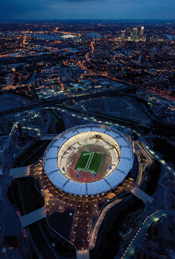The issue of security surrounding the London 2012 Games stretches far beyond the confines of the Olympic Park, argues Roger Ings.
The network of designated transport routes for competitors, their entourages and 2012 administrators permeates throughout the capital and raises wider questions for the security sector about just how much information to impart to staff working in retail and commercial premises lining those routes and who are located within the surroundings of the Olympic site. Transport for London is rolling out its strategy for easing congestion during the period of competition. A similar programme should be provided in a security context I believe, given that many see the threat of terrorism at this critical time when the world’s focus is on Britain.
Staff in particular posts – receptionists, office managers, front desk personnel and so on – need a basic knowledge to be able to act appropriately and, just as importantly, to instruct others in what they should do. The task is to train them up to the point where they avoid asking themselves that potentially fateful question: `What do I do`? Phones nowadays are universal and can be used at any time, in any place. A terror threat by phone can throw up key information that receptionists can be attuned to lock onto such as background noises, accents, nervousness or the excited state of the caller. Such possible vital information can be recorded on a form, prepared for the purpose. Later on, when a faulty memory may unwittingly mislead security personnel or the police, a true record is there to hand. But what can you do if you find something you feel is suspicious and a potential threat? Or someone reports that sort of incident to you? In the stress of the moment, the natural reaction is for your mind to go blank as you ponder just what you should do. You need something so ingrained that you immediately react without hesitation and remember what to do. This can be something as simple as the five Cs, universally used by police, military and security officers alike.
First: Confirm that the circumstances or items are suspicious as far as is possible.
Second: If you confirm it is suspicious, Clear people away from that area. You may not be able to move them to the recommended distances initially but move them away from the immediate vicinity behind hard cover at least and using the safest route. If only limited numbers are on duty, it may not be possible to manage the logistics of moving people the required distance immediately.
Third: Cordon the relevant area, using physical barriers wherever possible, including security tape to designate the cordoned area.
Four: Control the cordon by adding a presence at the barrier or tape. What will people do if you don’t? That’s right, duck under or step over the tape to go and retrieve something they left behind in the office. Remember, the two men killed in the South Quays bombing had gone back inside the cordon to retrieve their takings. Similarly, the journalist killed at the Bishopsgate bombing was inside the cordon.
Five: Check that the first four Cs have been completed, plus considering secondary hazards and devices at potential evacuation points and cordons.
Do your staff know the appropriate evacuation distances? If a briefcase or something of that size is the suspicious object, move people back 100m from it. Double that distance for a suitcase size device, and double it again to 400m for a vehicle. These are minimum distances that apply if hard cover, such as steel or concrete structures lie between the object and evacuees. Do you need to move people out of a building at all? Sections of a building are sometimes structurally strong enough to withstand a blast. It may be safer for them if you moved people to such predetermined areas, rather than evacuating them to a more exposed position outside. Structural surveys should be carried out beforehand to ensure this procedure is safe. In priority security locations such as the City and Canary Wharf, the assessments are likely to have been conducted. You’ll need to know what they conclude.
Time of day can also dictate your actions. At 3pm on a Saturday, staffing may be limited. Whoever’s in charge then (possibly only a supervisor) will need to be prepared to act appropriately in the event of an alert or warning. At 3am, employee numbers may be far fewer but they’ll still need to know the appropriate action to take. The security budget for Games period will permit the shows of strength recently witnessed on the Thames as forces recreated the conditions of, and response to, a water-borne terrorist attack. Away from such high profile `PR` exercises – necessary of course to tell the terrorist community that London is prepared for the worst – offices, shops, precincts and malls lie exposed to other lines of attack at any time of day or night. Front-line staff can play a key role by being trained to be alert to suspicious circumstances and being prepared to act appropriately in such eventualities. In as little as a day, receptionists for example can acquire the basic skills to recognise the techniques terrorists use, how they can enter a building with the components of a device and what they should do if their suspicions are aroused.
Roger Ings is managing director of Strings Security, which specialises in training, consultancy and equipment in counter-terrorism response, awareness and related issues to corporates and government agencies.










